Nursing - Sharon Case study 2022
VerifiedAdded on 2022/10/04
|10
|3106
|15
AI Summary
Contribute Materials
Your contribution can guide someone’s learning journey. Share your
documents today.

Nursing - Sharon Case study
Student's Name:
Student's ID:
Student's Name:
Student's ID:
Secure Best Marks with AI Grader
Need help grading? Try our AI Grader for instant feedback on your assignments.
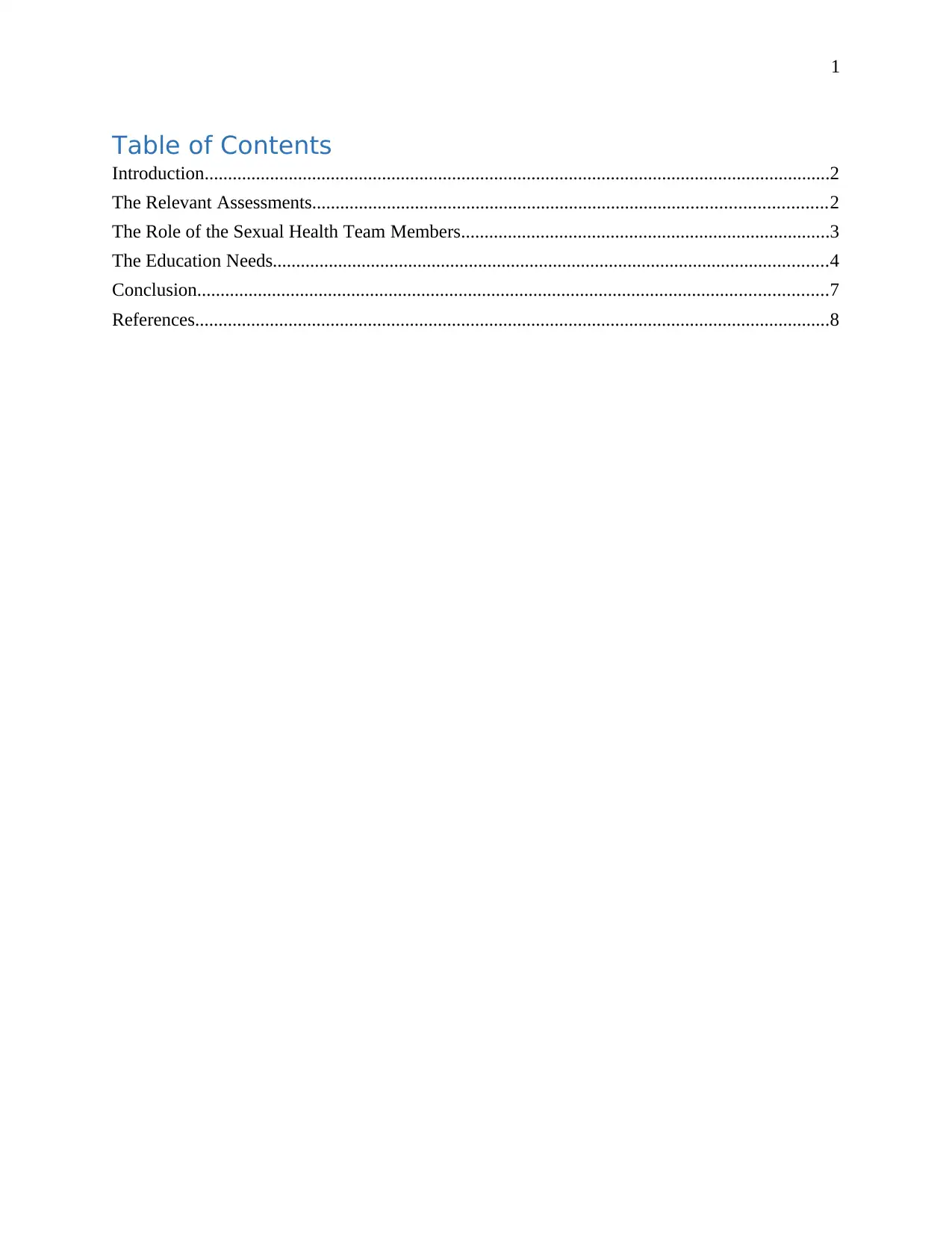
1
Table of Contents
Introduction......................................................................................................................................2
The Relevant Assessments..............................................................................................................2
The Role of the Sexual Health Team Members...............................................................................3
The Education Needs.......................................................................................................................4
Conclusion.......................................................................................................................................7
References........................................................................................................................................8
Table of Contents
Introduction......................................................................................................................................2
The Relevant Assessments..............................................................................................................2
The Role of the Sexual Health Team Members...............................................................................3
The Education Needs.......................................................................................................................4
Conclusion.......................................................................................................................................7
References........................................................................................................................................8
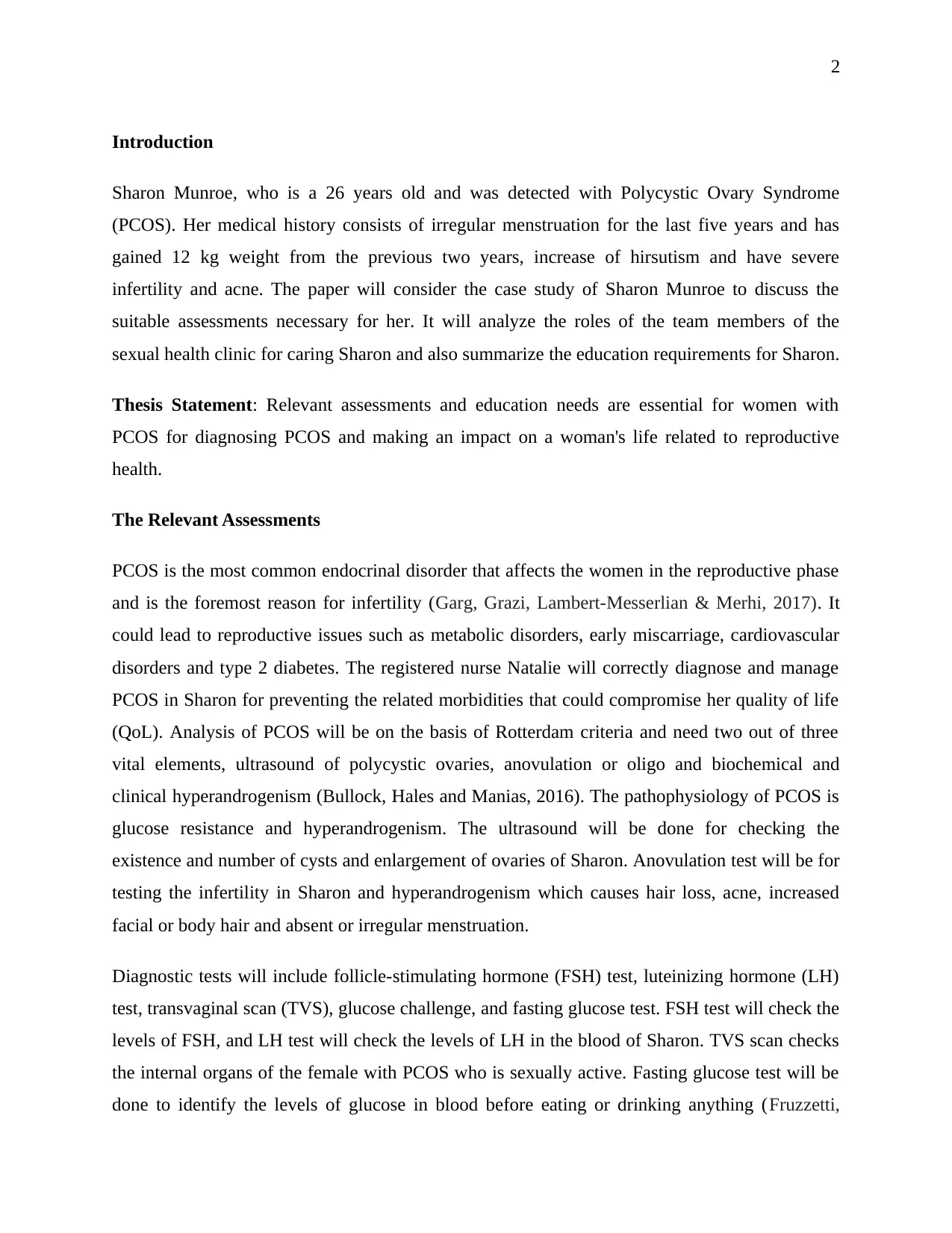
2
Introduction
Sharon Munroe, who is a 26 years old and was detected with Polycystic Ovary Syndrome
(PCOS). Her medical history consists of irregular menstruation for the last five years and has
gained 12 kg weight from the previous two years, increase of hirsutism and have severe
infertility and acne. The paper will consider the case study of Sharon Munroe to discuss the
suitable assessments necessary for her. It will analyze the roles of the team members of the
sexual health clinic for caring Sharon and also summarize the education requirements for Sharon.
Thesis Statement: Relevant assessments and education needs are essential for women with
PCOS for diagnosing PCOS and making an impact on a woman's life related to reproductive
health.
The Relevant Assessments
PCOS is the most common endocrinal disorder that affects the women in the reproductive phase
and is the foremost reason for infertility (Garg, Grazi, Lambert-Messerlian & Merhi, 2017). It
could lead to reproductive issues such as metabolic disorders, early miscarriage, cardiovascular
disorders and type 2 diabetes. The registered nurse Natalie will correctly diagnose and manage
PCOS in Sharon for preventing the related morbidities that could compromise her quality of life
(QoL). Analysis of PCOS will be on the basis of Rotterdam criteria and need two out of three
vital elements, ultrasound of polycystic ovaries, anovulation or oligo and biochemical and
clinical hyperandrogenism (Bullock, Hales and Manias, 2016). The pathophysiology of PCOS is
glucose resistance and hyperandrogenism. The ultrasound will be done for checking the
existence and number of cysts and enlargement of ovaries of Sharon. Anovulation test will be for
testing the infertility in Sharon and hyperandrogenism which causes hair loss, acne, increased
facial or body hair and absent or irregular menstruation.
Diagnostic tests will include follicle-stimulating hormone (FSH) test, luteinizing hormone (LH)
test, transvaginal scan (TVS), glucose challenge, and fasting glucose test. FSH test will check the
levels of FSH, and LH test will check the levels of LH in the blood of Sharon. TVS scan checks
the internal organs of the female with PCOS who is sexually active. Fasting glucose test will be
done to identify the levels of glucose in blood before eating or drinking anything (Fruzzetti,
Introduction
Sharon Munroe, who is a 26 years old and was detected with Polycystic Ovary Syndrome
(PCOS). Her medical history consists of irregular menstruation for the last five years and has
gained 12 kg weight from the previous two years, increase of hirsutism and have severe
infertility and acne. The paper will consider the case study of Sharon Munroe to discuss the
suitable assessments necessary for her. It will analyze the roles of the team members of the
sexual health clinic for caring Sharon and also summarize the education requirements for Sharon.
Thesis Statement: Relevant assessments and education needs are essential for women with
PCOS for diagnosing PCOS and making an impact on a woman's life related to reproductive
health.
The Relevant Assessments
PCOS is the most common endocrinal disorder that affects the women in the reproductive phase
and is the foremost reason for infertility (Garg, Grazi, Lambert-Messerlian & Merhi, 2017). It
could lead to reproductive issues such as metabolic disorders, early miscarriage, cardiovascular
disorders and type 2 diabetes. The registered nurse Natalie will correctly diagnose and manage
PCOS in Sharon for preventing the related morbidities that could compromise her quality of life
(QoL). Analysis of PCOS will be on the basis of Rotterdam criteria and need two out of three
vital elements, ultrasound of polycystic ovaries, anovulation or oligo and biochemical and
clinical hyperandrogenism (Bullock, Hales and Manias, 2016). The pathophysiology of PCOS is
glucose resistance and hyperandrogenism. The ultrasound will be done for checking the
existence and number of cysts and enlargement of ovaries of Sharon. Anovulation test will be for
testing the infertility in Sharon and hyperandrogenism which causes hair loss, acne, increased
facial or body hair and absent or irregular menstruation.
Diagnostic tests will include follicle-stimulating hormone (FSH) test, luteinizing hormone (LH)
test, transvaginal scan (TVS), glucose challenge, and fasting glucose test. FSH test will check the
levels of FSH, and LH test will check the levels of LH in the blood of Sharon. TVS scan checks
the internal organs of the female with PCOS who is sexually active. Fasting glucose test will be
done to identify the levels of glucose in blood before eating or drinking anything (Fruzzetti,
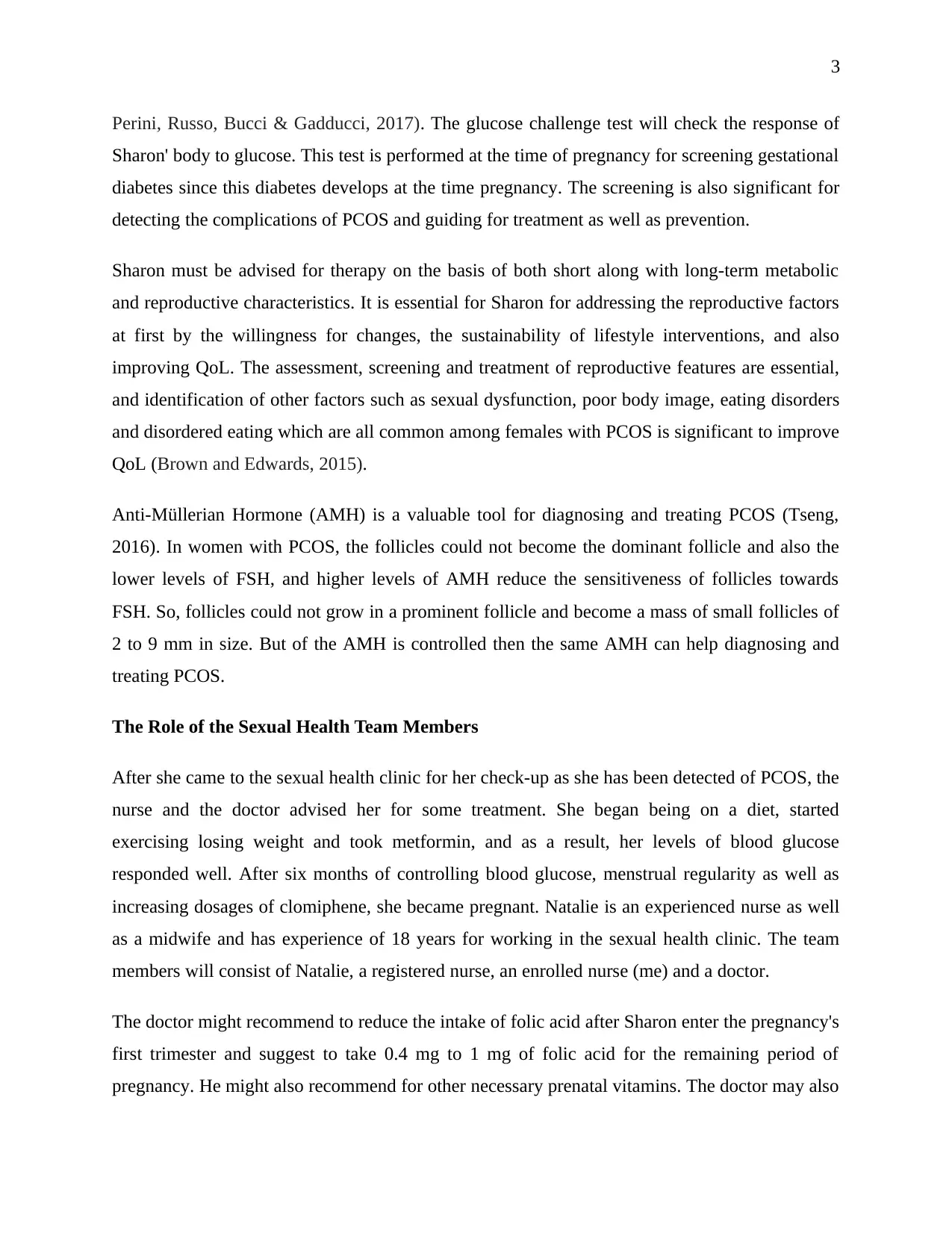
3
Perini, Russo, Bucci & Gadducci, 2017). The glucose challenge test will check the response of
Sharon' body to glucose. This test is performed at the time of pregnancy for screening gestational
diabetes since this diabetes develops at the time pregnancy. The screening is also significant for
detecting the complications of PCOS and guiding for treatment as well as prevention.
Sharon must be advised for therapy on the basis of both short along with long-term metabolic
and reproductive characteristics. It is essential for Sharon for addressing the reproductive factors
at first by the willingness for changes, the sustainability of lifestyle interventions, and also
improving QoL. The assessment, screening and treatment of reproductive features are essential,
and identification of other factors such as sexual dysfunction, poor body image, eating disorders
and disordered eating which are all common among females with PCOS is significant to improve
QoL (Brown and Edwards, 2015).
Anti-Müllerian Hormone (AMH) is a valuable tool for diagnosing and treating PCOS (Tseng,
2016). In women with PCOS, the follicles could not become the dominant follicle and also the
lower levels of FSH, and higher levels of AMH reduce the sensitiveness of follicles towards
FSH. So, follicles could not grow in a prominent follicle and become a mass of small follicles of
2 to 9 mm in size. But of the AMH is controlled then the same AMH can help diagnosing and
treating PCOS.
The Role of the Sexual Health Team Members
After she came to the sexual health clinic for her check-up as she has been detected of PCOS, the
nurse and the doctor advised her for some treatment. She began being on a diet, started
exercising losing weight and took metformin, and as a result, her levels of blood glucose
responded well. After six months of controlling blood glucose, menstrual regularity as well as
increasing dosages of clomiphene, she became pregnant. Natalie is an experienced nurse as well
as a midwife and has experience of 18 years for working in the sexual health clinic. The team
members will consist of Natalie, a registered nurse, an enrolled nurse (me) and a doctor.
The doctor might recommend to reduce the intake of folic acid after Sharon enter the pregnancy's
first trimester and suggest to take 0.4 mg to 1 mg of folic acid for the remaining period of
pregnancy. He might also recommend for other necessary prenatal vitamins. The doctor may also
Perini, Russo, Bucci & Gadducci, 2017). The glucose challenge test will check the response of
Sharon' body to glucose. This test is performed at the time of pregnancy for screening gestational
diabetes since this diabetes develops at the time pregnancy. The screening is also significant for
detecting the complications of PCOS and guiding for treatment as well as prevention.
Sharon must be advised for therapy on the basis of both short along with long-term metabolic
and reproductive characteristics. It is essential for Sharon for addressing the reproductive factors
at first by the willingness for changes, the sustainability of lifestyle interventions, and also
improving QoL. The assessment, screening and treatment of reproductive features are essential,
and identification of other factors such as sexual dysfunction, poor body image, eating disorders
and disordered eating which are all common among females with PCOS is significant to improve
QoL (Brown and Edwards, 2015).
Anti-Müllerian Hormone (AMH) is a valuable tool for diagnosing and treating PCOS (Tseng,
2016). In women with PCOS, the follicles could not become the dominant follicle and also the
lower levels of FSH, and higher levels of AMH reduce the sensitiveness of follicles towards
FSH. So, follicles could not grow in a prominent follicle and become a mass of small follicles of
2 to 9 mm in size. But of the AMH is controlled then the same AMH can help diagnosing and
treating PCOS.
The Role of the Sexual Health Team Members
After she came to the sexual health clinic for her check-up as she has been detected of PCOS, the
nurse and the doctor advised her for some treatment. She began being on a diet, started
exercising losing weight and took metformin, and as a result, her levels of blood glucose
responded well. After six months of controlling blood glucose, menstrual regularity as well as
increasing dosages of clomiphene, she became pregnant. Natalie is an experienced nurse as well
as a midwife and has experience of 18 years for working in the sexual health clinic. The team
members will consist of Natalie, a registered nurse, an enrolled nurse (me) and a doctor.
The doctor might recommend to reduce the intake of folic acid after Sharon enter the pregnancy's
first trimester and suggest to take 0.4 mg to 1 mg of folic acid for the remaining period of
pregnancy. He might also recommend for other necessary prenatal vitamins. The doctor may also
Secure Best Marks with AI Grader
Need help grading? Try our AI Grader for instant feedback on your assignments.
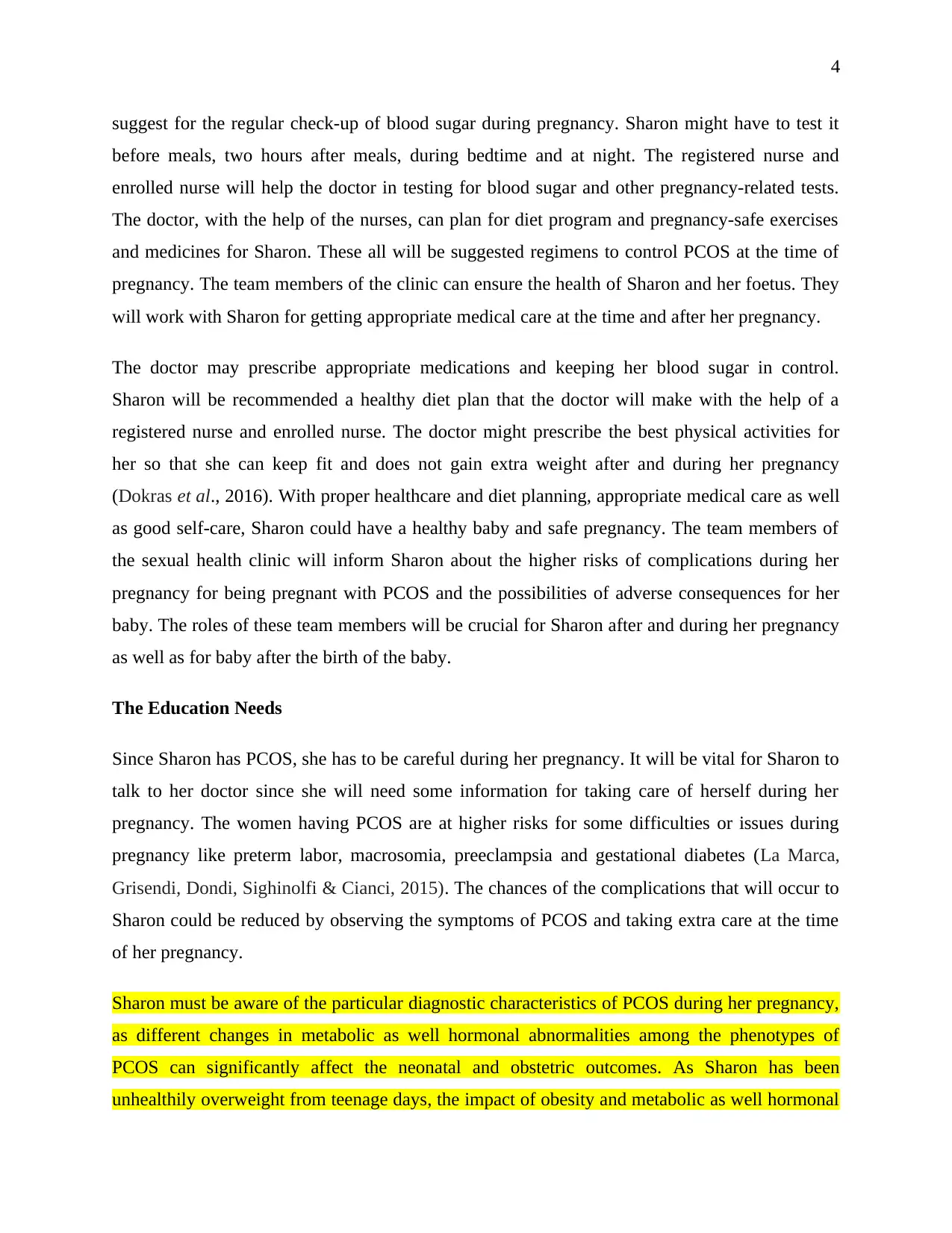
4
suggest for the regular check-up of blood sugar during pregnancy. Sharon might have to test it
before meals, two hours after meals, during bedtime and at night. The registered nurse and
enrolled nurse will help the doctor in testing for blood sugar and other pregnancy-related tests.
The doctor, with the help of the nurses, can plan for diet program and pregnancy-safe exercises
and medicines for Sharon. These all will be suggested regimens to control PCOS at the time of
pregnancy. The team members of the clinic can ensure the health of Sharon and her foetus. They
will work with Sharon for getting appropriate medical care at the time and after her pregnancy.
The doctor may prescribe appropriate medications and keeping her blood sugar in control.
Sharon will be recommended a healthy diet plan that the doctor will make with the help of a
registered nurse and enrolled nurse. The doctor might prescribe the best physical activities for
her so that she can keep fit and does not gain extra weight after and during her pregnancy
(Dokras et al., 2016). With proper healthcare and diet planning, appropriate medical care as well
as good self-care, Sharon could have a healthy baby and safe pregnancy. The team members of
the sexual health clinic will inform Sharon about the higher risks of complications during her
pregnancy for being pregnant with PCOS and the possibilities of adverse consequences for her
baby. The roles of these team members will be crucial for Sharon after and during her pregnancy
as well as for baby after the birth of the baby.
The Education Needs
Since Sharon has PCOS, she has to be careful during her pregnancy. It will be vital for Sharon to
talk to her doctor since she will need some information for taking care of herself during her
pregnancy. The women having PCOS are at higher risks for some difficulties or issues during
pregnancy like preterm labor, macrosomia, preeclampsia and gestational diabetes (La Marca,
Grisendi, Dondi, Sighinolfi & Cianci, 2015). The chances of the complications that will occur to
Sharon could be reduced by observing the symptoms of PCOS and taking extra care at the time
of her pregnancy.
Sharon must be aware of the particular diagnostic characteristics of PCOS during her pregnancy,
as different changes in metabolic as well hormonal abnormalities among the phenotypes of
PCOS can significantly affect the neonatal and obstetric outcomes. As Sharon has been
unhealthily overweight from teenage days, the impact of obesity and metabolic as well hormonal
suggest for the regular check-up of blood sugar during pregnancy. Sharon might have to test it
before meals, two hours after meals, during bedtime and at night. The registered nurse and
enrolled nurse will help the doctor in testing for blood sugar and other pregnancy-related tests.
The doctor, with the help of the nurses, can plan for diet program and pregnancy-safe exercises
and medicines for Sharon. These all will be suggested regimens to control PCOS at the time of
pregnancy. The team members of the clinic can ensure the health of Sharon and her foetus. They
will work with Sharon for getting appropriate medical care at the time and after her pregnancy.
The doctor may prescribe appropriate medications and keeping her blood sugar in control.
Sharon will be recommended a healthy diet plan that the doctor will make with the help of a
registered nurse and enrolled nurse. The doctor might prescribe the best physical activities for
her so that she can keep fit and does not gain extra weight after and during her pregnancy
(Dokras et al., 2016). With proper healthcare and diet planning, appropriate medical care as well
as good self-care, Sharon could have a healthy baby and safe pregnancy. The team members of
the sexual health clinic will inform Sharon about the higher risks of complications during her
pregnancy for being pregnant with PCOS and the possibilities of adverse consequences for her
baby. The roles of these team members will be crucial for Sharon after and during her pregnancy
as well as for baby after the birth of the baby.
The Education Needs
Since Sharon has PCOS, she has to be careful during her pregnancy. It will be vital for Sharon to
talk to her doctor since she will need some information for taking care of herself during her
pregnancy. The women having PCOS are at higher risks for some difficulties or issues during
pregnancy like preterm labor, macrosomia, preeclampsia and gestational diabetes (La Marca,
Grisendi, Dondi, Sighinolfi & Cianci, 2015). The chances of the complications that will occur to
Sharon could be reduced by observing the symptoms of PCOS and taking extra care at the time
of her pregnancy.
Sharon must be aware of the particular diagnostic characteristics of PCOS during her pregnancy,
as different changes in metabolic as well hormonal abnormalities among the phenotypes of
PCOS can significantly affect the neonatal and obstetric outcomes. As Sharon has been
unhealthily overweight from teenage days, the impact of obesity and metabolic as well hormonal
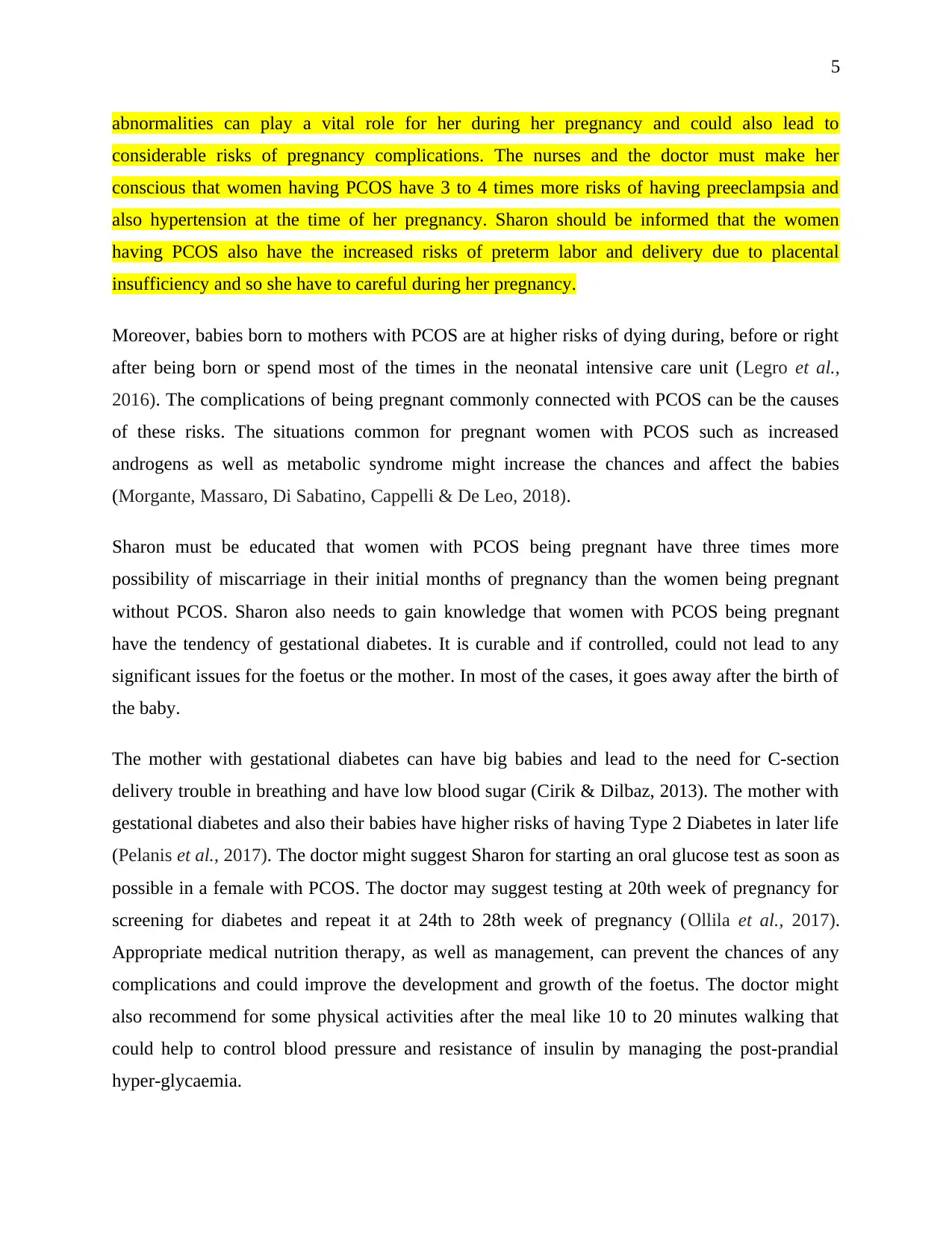
5
abnormalities can play a vital role for her during her pregnancy and could also lead to
considerable risks of pregnancy complications. The nurses and the doctor must make her
conscious that women having PCOS have 3 to 4 times more risks of having preeclampsia and
also hypertension at the time of her pregnancy. Sharon should be informed that the women
having PCOS also have the increased risks of preterm labor and delivery due to placental
insufficiency and so she have to careful during her pregnancy.
Moreover, babies born to mothers with PCOS are at higher risks of dying during, before or right
after being born or spend most of the times in the neonatal intensive care unit (Legro et al.,
2016). The complications of being pregnant commonly connected with PCOS can be the causes
of these risks. The situations common for pregnant women with PCOS such as increased
androgens as well as metabolic syndrome might increase the chances and affect the babies
(Morgante, Massaro, Di Sabatino, Cappelli & De Leo, 2018).
Sharon must be educated that women with PCOS being pregnant have three times more
possibility of miscarriage in their initial months of pregnancy than the women being pregnant
without PCOS. Sharon also needs to gain knowledge that women with PCOS being pregnant
have the tendency of gestational diabetes. It is curable and if controlled, could not lead to any
significant issues for the foetus or the mother. In most of the cases, it goes away after the birth of
the baby.
The mother with gestational diabetes can have big babies and lead to the need for C-section
delivery trouble in breathing and have low blood sugar (Cirik & Dilbaz, 2013). The mother with
gestational diabetes and also their babies have higher risks of having Type 2 Diabetes in later life
(Pelanis et al., 2017). The doctor might suggest Sharon for starting an oral glucose test as soon as
possible in a female with PCOS. The doctor may suggest testing at 20th week of pregnancy for
screening for diabetes and repeat it at 24th to 28th week of pregnancy (Ollila et al., 2017).
Appropriate medical nutrition therapy, as well as management, can prevent the chances of any
complications and could improve the development and growth of the foetus. The doctor might
also recommend for some physical activities after the meal like 10 to 20 minutes walking that
could help to control blood pressure and resistance of insulin by managing the post-prandial
hyper-glycaemia.
abnormalities can play a vital role for her during her pregnancy and could also lead to
considerable risks of pregnancy complications. The nurses and the doctor must make her
conscious that women having PCOS have 3 to 4 times more risks of having preeclampsia and
also hypertension at the time of her pregnancy. Sharon should be informed that the women
having PCOS also have the increased risks of preterm labor and delivery due to placental
insufficiency and so she have to careful during her pregnancy.
Moreover, babies born to mothers with PCOS are at higher risks of dying during, before or right
after being born or spend most of the times in the neonatal intensive care unit (Legro et al.,
2016). The complications of being pregnant commonly connected with PCOS can be the causes
of these risks. The situations common for pregnant women with PCOS such as increased
androgens as well as metabolic syndrome might increase the chances and affect the babies
(Morgante, Massaro, Di Sabatino, Cappelli & De Leo, 2018).
Sharon must be educated that women with PCOS being pregnant have three times more
possibility of miscarriage in their initial months of pregnancy than the women being pregnant
without PCOS. Sharon also needs to gain knowledge that women with PCOS being pregnant
have the tendency of gestational diabetes. It is curable and if controlled, could not lead to any
significant issues for the foetus or the mother. In most of the cases, it goes away after the birth of
the baby.
The mother with gestational diabetes can have big babies and lead to the need for C-section
delivery trouble in breathing and have low blood sugar (Cirik & Dilbaz, 2013). The mother with
gestational diabetes and also their babies have higher risks of having Type 2 Diabetes in later life
(Pelanis et al., 2017). The doctor might suggest Sharon for starting an oral glucose test as soon as
possible in a female with PCOS. The doctor may suggest testing at 20th week of pregnancy for
screening for diabetes and repeat it at 24th to 28th week of pregnancy (Ollila et al., 2017).
Appropriate medical nutrition therapy, as well as management, can prevent the chances of any
complications and could improve the development and growth of the foetus. The doctor might
also recommend for some physical activities after the meal like 10 to 20 minutes walking that
could help to control blood pressure and resistance of insulin by managing the post-prandial
hyper-glycaemia.
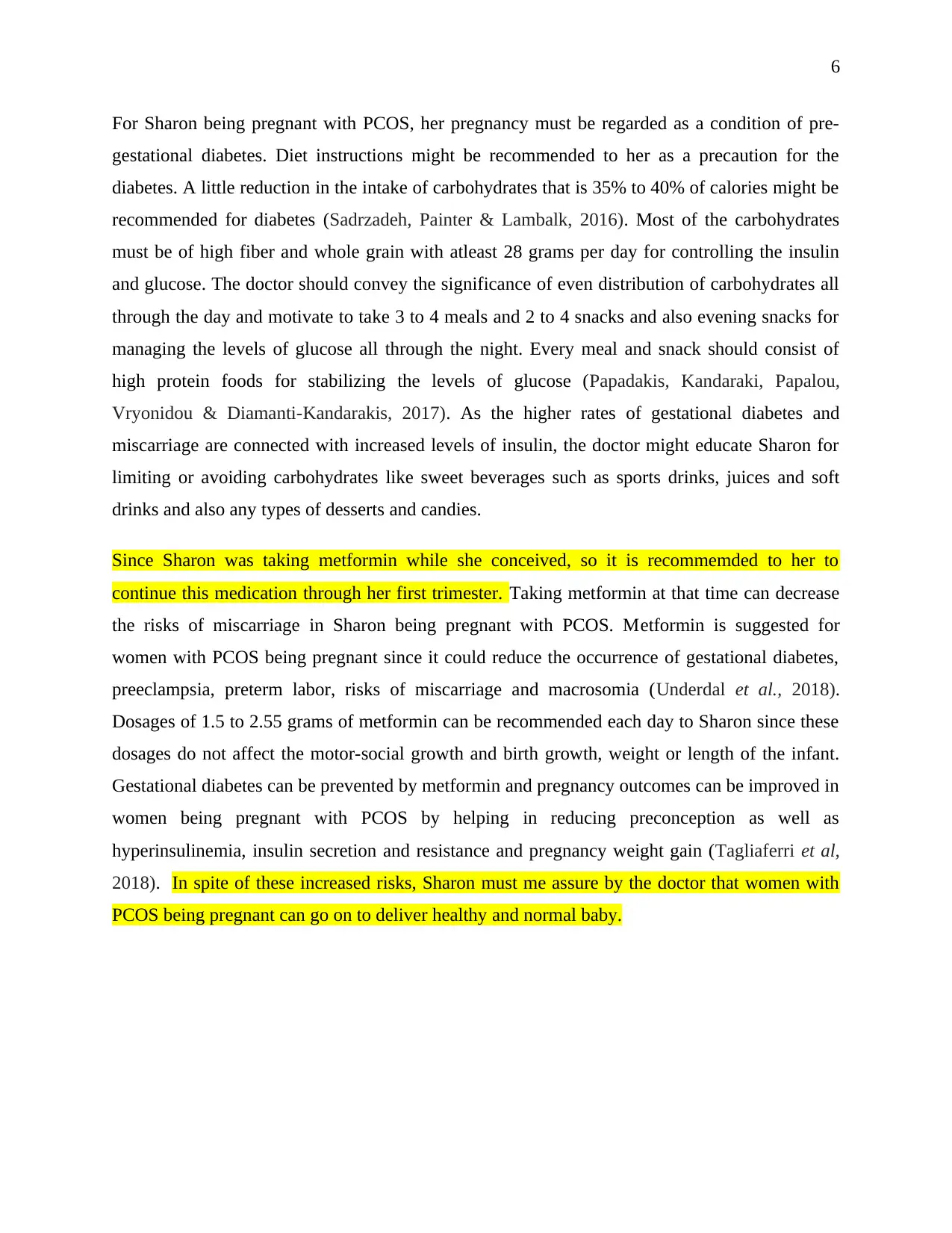
6
For Sharon being pregnant with PCOS, her pregnancy must be regarded as a condition of pre-
gestational diabetes. Diet instructions might be recommended to her as a precaution for the
diabetes. A little reduction in the intake of carbohydrates that is 35% to 40% of calories might be
recommended for diabetes (Sadrzadeh, Painter & Lambalk, 2016). Most of the carbohydrates
must be of high fiber and whole grain with atleast 28 grams per day for controlling the insulin
and glucose. The doctor should convey the significance of even distribution of carbohydrates all
through the day and motivate to take 3 to 4 meals and 2 to 4 snacks and also evening snacks for
managing the levels of glucose all through the night. Every meal and snack should consist of
high protein foods for stabilizing the levels of glucose (Papadakis, Kandaraki, Papalou,
Vryonidou & Diamanti-Kandarakis, 2017). As the higher rates of gestational diabetes and
miscarriage are connected with increased levels of insulin, the doctor might educate Sharon for
limiting or avoiding carbohydrates like sweet beverages such as sports drinks, juices and soft
drinks and also any types of desserts and candies.
Since Sharon was taking metformin while she conceived, so it is recommemded to her to
continue this medication through her first trimester. Taking metformin at that time can decrease
the risks of miscarriage in Sharon being pregnant with PCOS. Metformin is suggested for
women with PCOS being pregnant since it could reduce the occurrence of gestational diabetes,
preeclampsia, preterm labor, risks of miscarriage and macrosomia (Underdal et al., 2018).
Dosages of 1.5 to 2.55 grams of metformin can be recommended each day to Sharon since these
dosages do not affect the motor-social growth and birth growth, weight or length of the infant.
Gestational diabetes can be prevented by metformin and pregnancy outcomes can be improved in
women being pregnant with PCOS by helping in reducing preconception as well as
hyperinsulinemia, insulin secretion and resistance and pregnancy weight gain (Tagliaferri et al,
2018). In spite of these increased risks, Sharon must me assure by the doctor that women with
PCOS being pregnant can go on to deliver healthy and normal baby.
For Sharon being pregnant with PCOS, her pregnancy must be regarded as a condition of pre-
gestational diabetes. Diet instructions might be recommended to her as a precaution for the
diabetes. A little reduction in the intake of carbohydrates that is 35% to 40% of calories might be
recommended for diabetes (Sadrzadeh, Painter & Lambalk, 2016). Most of the carbohydrates
must be of high fiber and whole grain with atleast 28 grams per day for controlling the insulin
and glucose. The doctor should convey the significance of even distribution of carbohydrates all
through the day and motivate to take 3 to 4 meals and 2 to 4 snacks and also evening snacks for
managing the levels of glucose all through the night. Every meal and snack should consist of
high protein foods for stabilizing the levels of glucose (Papadakis, Kandaraki, Papalou,
Vryonidou & Diamanti-Kandarakis, 2017). As the higher rates of gestational diabetes and
miscarriage are connected with increased levels of insulin, the doctor might educate Sharon for
limiting or avoiding carbohydrates like sweet beverages such as sports drinks, juices and soft
drinks and also any types of desserts and candies.
Since Sharon was taking metformin while she conceived, so it is recommemded to her to
continue this medication through her first trimester. Taking metformin at that time can decrease
the risks of miscarriage in Sharon being pregnant with PCOS. Metformin is suggested for
women with PCOS being pregnant since it could reduce the occurrence of gestational diabetes,
preeclampsia, preterm labor, risks of miscarriage and macrosomia (Underdal et al., 2018).
Dosages of 1.5 to 2.55 grams of metformin can be recommended each day to Sharon since these
dosages do not affect the motor-social growth and birth growth, weight or length of the infant.
Gestational diabetes can be prevented by metformin and pregnancy outcomes can be improved in
women being pregnant with PCOS by helping in reducing preconception as well as
hyperinsulinemia, insulin secretion and resistance and pregnancy weight gain (Tagliaferri et al,
2018). In spite of these increased risks, Sharon must me assure by the doctor that women with
PCOS being pregnant can go on to deliver healthy and normal baby.
Paraphrase This Document
Need a fresh take? Get an instant paraphrase of this document with our AI Paraphraser
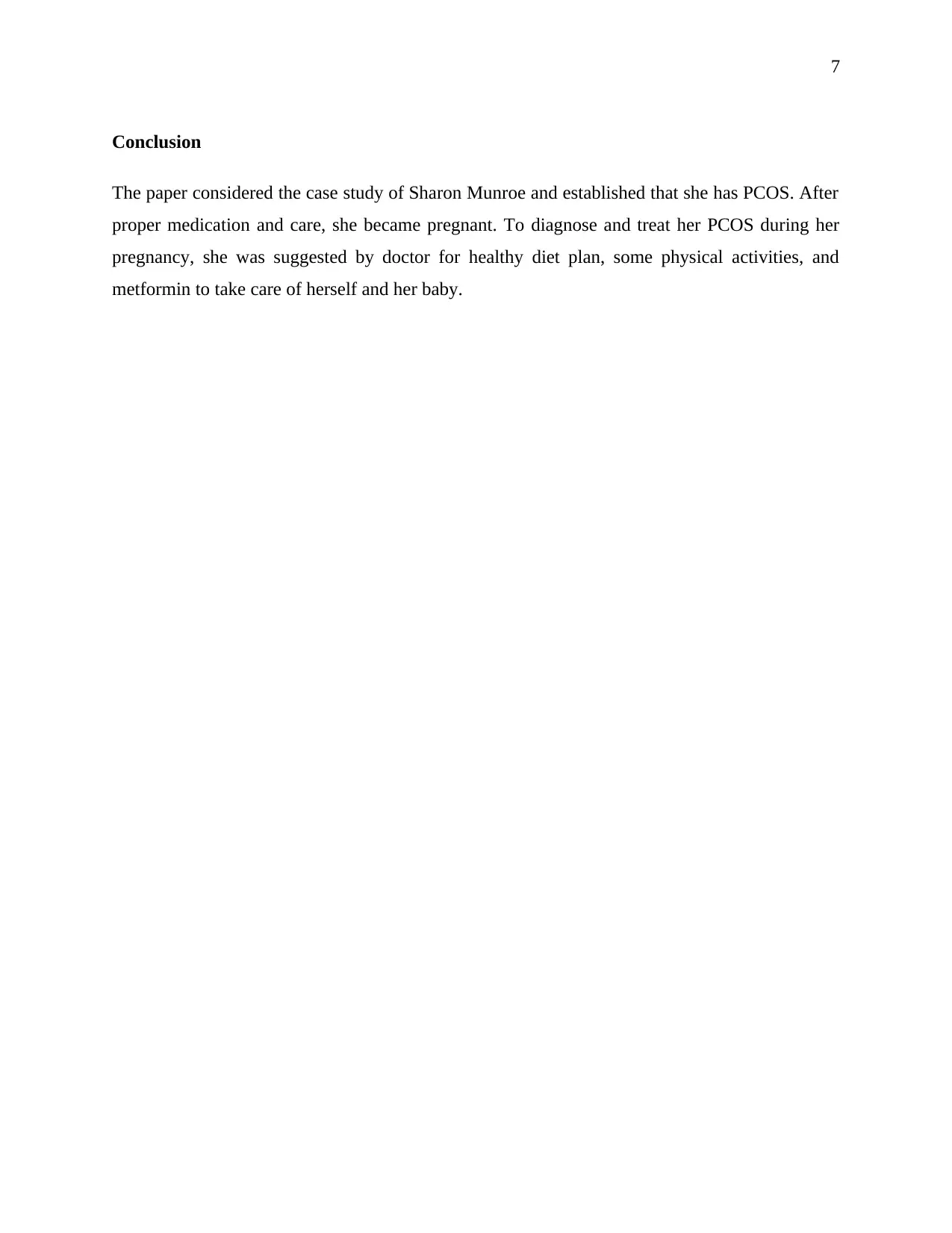
7
Conclusion
The paper considered the case study of Sharon Munroe and established that she has PCOS. After
proper medication and care, she became pregnant. To diagnose and treat her PCOS during her
pregnancy, she was suggested by doctor for healthy diet plan, some physical activities, and
metformin to take care of herself and her baby.
Conclusion
The paper considered the case study of Sharon Munroe and established that she has PCOS. After
proper medication and care, she became pregnant. To diagnose and treat her PCOS during her
pregnancy, she was suggested by doctor for healthy diet plan, some physical activities, and
metformin to take care of herself and her baby.
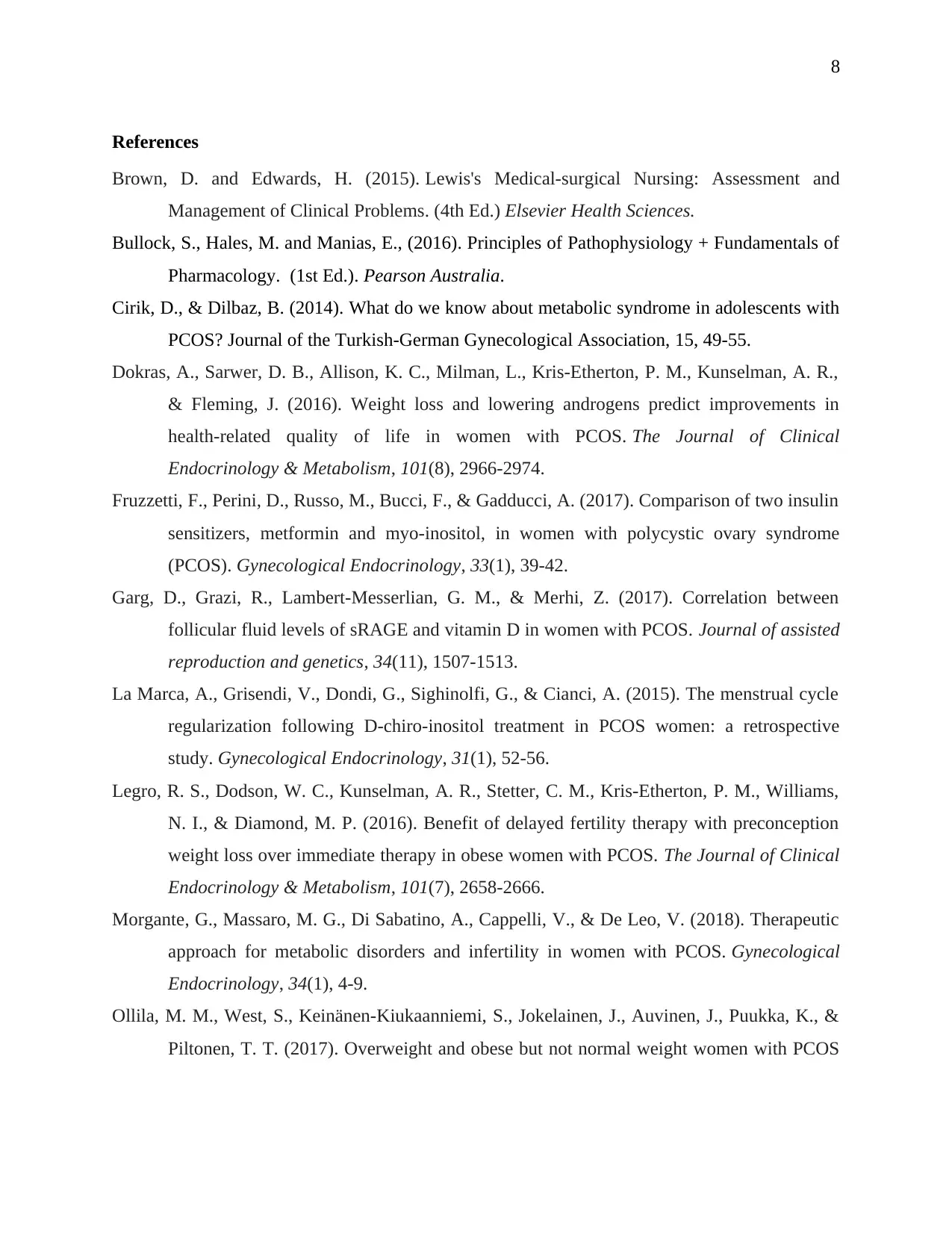
8
References
Brown, D. and Edwards, H. (2015). Lewis's Medical-surgical Nursing: Assessment and
Management of Clinical Problems. (4th Ed.) Elsevier Health Sciences.
Bullock, S., Hales, M. and Manias, E., (2016). Principles of Pathophysiology + Fundamentals of
Pharmacology. (1st Ed.). Pearson Australia.
Cirik, D., & Dilbaz, B. (2014). What do we know about metabolic syndrome in adolescents with
PCOS? Journal of the Turkish-German Gynecological Association, 15, 49-55.
Dokras, A., Sarwer, D. B., Allison, K. C., Milman, L., Kris-Etherton, P. M., Kunselman, A. R.,
& Fleming, J. (2016). Weight loss and lowering androgens predict improvements in
health-related quality of life in women with PCOS. The Journal of Clinical
Endocrinology & Metabolism, 101(8), 2966-2974.
Fruzzetti, F., Perini, D., Russo, M., Bucci, F., & Gadducci, A. (2017). Comparison of two insulin
sensitizers, metformin and myo-inositol, in women with polycystic ovary syndrome
(PCOS). Gynecological Endocrinology, 33(1), 39-42.
Garg, D., Grazi, R., Lambert-Messerlian, G. M., & Merhi, Z. (2017). Correlation between
follicular fluid levels of sRAGE and vitamin D in women with PCOS. Journal of assisted
reproduction and genetics, 34(11), 1507-1513.
La Marca, A., Grisendi, V., Dondi, G., Sighinolfi, G., & Cianci, A. (2015). The menstrual cycle
regularization following D-chiro-inositol treatment in PCOS women: a retrospective
study. Gynecological Endocrinology, 31(1), 52-56.
Legro, R. S., Dodson, W. C., Kunselman, A. R., Stetter, C. M., Kris-Etherton, P. M., Williams,
N. I., & Diamond, M. P. (2016). Benefit of delayed fertility therapy with preconception
weight loss over immediate therapy in obese women with PCOS. The Journal of Clinical
Endocrinology & Metabolism, 101(7), 2658-2666.
Morgante, G., Massaro, M. G., Di Sabatino, A., Cappelli, V., & De Leo, V. (2018). Therapeutic
approach for metabolic disorders and infertility in women with PCOS. Gynecological
Endocrinology, 34(1), 4-9.
Ollila, M. M., West, S., Keinänen-Kiukaanniemi, S., Jokelainen, J., Auvinen, J., Puukka, K., &
Piltonen, T. T. (2017). Overweight and obese but not normal weight women with PCOS
References
Brown, D. and Edwards, H. (2015). Lewis's Medical-surgical Nursing: Assessment and
Management of Clinical Problems. (4th Ed.) Elsevier Health Sciences.
Bullock, S., Hales, M. and Manias, E., (2016). Principles of Pathophysiology + Fundamentals of
Pharmacology. (1st Ed.). Pearson Australia.
Cirik, D., & Dilbaz, B. (2014). What do we know about metabolic syndrome in adolescents with
PCOS? Journal of the Turkish-German Gynecological Association, 15, 49-55.
Dokras, A., Sarwer, D. B., Allison, K. C., Milman, L., Kris-Etherton, P. M., Kunselman, A. R.,
& Fleming, J. (2016). Weight loss and lowering androgens predict improvements in
health-related quality of life in women with PCOS. The Journal of Clinical
Endocrinology & Metabolism, 101(8), 2966-2974.
Fruzzetti, F., Perini, D., Russo, M., Bucci, F., & Gadducci, A. (2017). Comparison of two insulin
sensitizers, metformin and myo-inositol, in women with polycystic ovary syndrome
(PCOS). Gynecological Endocrinology, 33(1), 39-42.
Garg, D., Grazi, R., Lambert-Messerlian, G. M., & Merhi, Z. (2017). Correlation between
follicular fluid levels of sRAGE and vitamin D in women with PCOS. Journal of assisted
reproduction and genetics, 34(11), 1507-1513.
La Marca, A., Grisendi, V., Dondi, G., Sighinolfi, G., & Cianci, A. (2015). The menstrual cycle
regularization following D-chiro-inositol treatment in PCOS women: a retrospective
study. Gynecological Endocrinology, 31(1), 52-56.
Legro, R. S., Dodson, W. C., Kunselman, A. R., Stetter, C. M., Kris-Etherton, P. M., Williams,
N. I., & Diamond, M. P. (2016). Benefit of delayed fertility therapy with preconception
weight loss over immediate therapy in obese women with PCOS. The Journal of Clinical
Endocrinology & Metabolism, 101(7), 2658-2666.
Morgante, G., Massaro, M. G., Di Sabatino, A., Cappelli, V., & De Leo, V. (2018). Therapeutic
approach for metabolic disorders and infertility in women with PCOS. Gynecological
Endocrinology, 34(1), 4-9.
Ollila, M. M., West, S., Keinänen-Kiukaanniemi, S., Jokelainen, J., Auvinen, J., Puukka, K., &
Piltonen, T. T. (2017). Overweight and obese but not normal weight women with PCOS
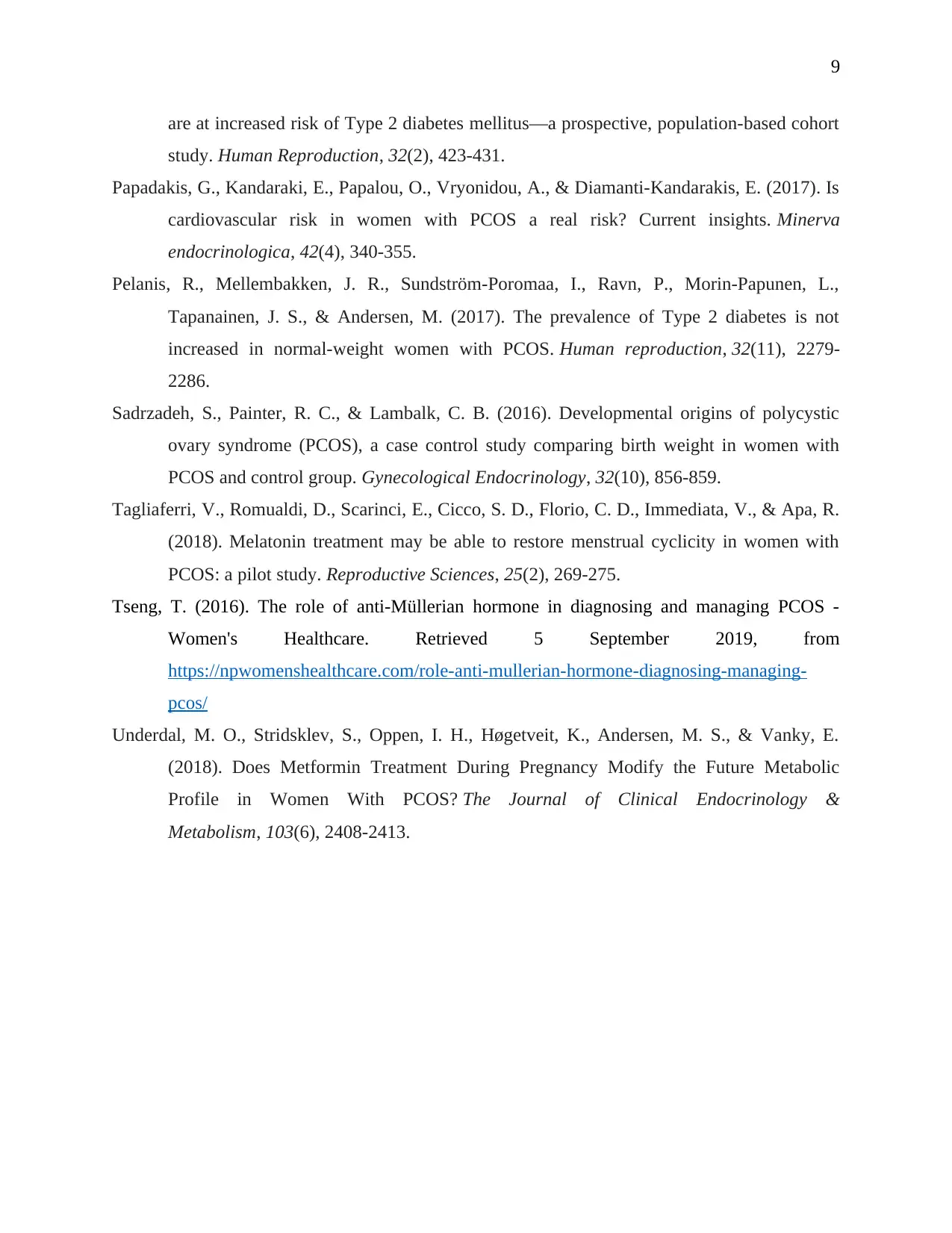
9
are at increased risk of Type 2 diabetes mellitus—a prospective, population-based cohort
study. Human Reproduction, 32(2), 423-431.
Papadakis, G., Kandaraki, E., Papalou, O., Vryonidou, A., & Diamanti-Kandarakis, E. (2017). Is
cardiovascular risk in women with PCOS a real risk? Current insights. Minerva
endocrinologica, 42(4), 340-355.
Pelanis, R., Mellembakken, J. R., Sundström-Poromaa, I., Ravn, P., Morin-Papunen, L.,
Tapanainen, J. S., & Andersen, M. (2017). The prevalence of Type 2 diabetes is not
increased in normal-weight women with PCOS. Human reproduction, 32(11), 2279-
2286.
Sadrzadeh, S., Painter, R. C., & Lambalk, C. B. (2016). Developmental origins of polycystic
ovary syndrome (PCOS), a case control study comparing birth weight in women with
PCOS and control group. Gynecological Endocrinology, 32(10), 856-859.
Tagliaferri, V., Romualdi, D., Scarinci, E., Cicco, S. D., Florio, C. D., Immediata, V., & Apa, R.
(2018). Melatonin treatment may be able to restore menstrual cyclicity in women with
PCOS: a pilot study. Reproductive Sciences, 25(2), 269-275.
Tseng, T. (2016). The role of anti-Müllerian hormone in diagnosing and managing PCOS -
Women's Healthcare. Retrieved 5 September 2019, from
https://npwomenshealthcare.com/role-anti-mullerian-hormone-diagnosing-managing-
pcos/
Underdal, M. O., Stridsklev, S., Oppen, I. H., Høgetveit, K., Andersen, M. S., & Vanky, E.
(2018). Does Metformin Treatment During Pregnancy Modify the Future Metabolic
Profile in Women With PCOS? The Journal of Clinical Endocrinology &
Metabolism, 103(6), 2408-2413.
are at increased risk of Type 2 diabetes mellitus—a prospective, population-based cohort
study. Human Reproduction, 32(2), 423-431.
Papadakis, G., Kandaraki, E., Papalou, O., Vryonidou, A., & Diamanti-Kandarakis, E. (2017). Is
cardiovascular risk in women with PCOS a real risk? Current insights. Minerva
endocrinologica, 42(4), 340-355.
Pelanis, R., Mellembakken, J. R., Sundström-Poromaa, I., Ravn, P., Morin-Papunen, L.,
Tapanainen, J. S., & Andersen, M. (2017). The prevalence of Type 2 diabetes is not
increased in normal-weight women with PCOS. Human reproduction, 32(11), 2279-
2286.
Sadrzadeh, S., Painter, R. C., & Lambalk, C. B. (2016). Developmental origins of polycystic
ovary syndrome (PCOS), a case control study comparing birth weight in women with
PCOS and control group. Gynecological Endocrinology, 32(10), 856-859.
Tagliaferri, V., Romualdi, D., Scarinci, E., Cicco, S. D., Florio, C. D., Immediata, V., & Apa, R.
(2018). Melatonin treatment may be able to restore menstrual cyclicity in women with
PCOS: a pilot study. Reproductive Sciences, 25(2), 269-275.
Tseng, T. (2016). The role of anti-Müllerian hormone in diagnosing and managing PCOS -
Women's Healthcare. Retrieved 5 September 2019, from
https://npwomenshealthcare.com/role-anti-mullerian-hormone-diagnosing-managing-
pcos/
Underdal, M. O., Stridsklev, S., Oppen, I. H., Høgetveit, K., Andersen, M. S., & Vanky, E.
(2018). Does Metformin Treatment During Pregnancy Modify the Future Metabolic
Profile in Women With PCOS? The Journal of Clinical Endocrinology &
Metabolism, 103(6), 2408-2413.
1 out of 10
Related Documents
Your All-in-One AI-Powered Toolkit for Academic Success.
+13062052269
info@desklib.com
Available 24*7 on WhatsApp / Email
![[object Object]](/_next/static/media/star-bottom.7253800d.svg)
Unlock your academic potential
© 2024 | Zucol Services PVT LTD | All rights reserved.





